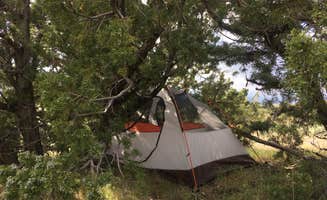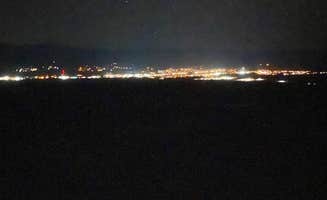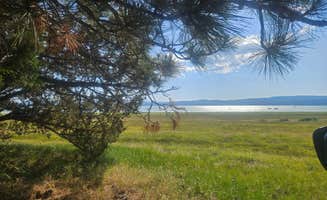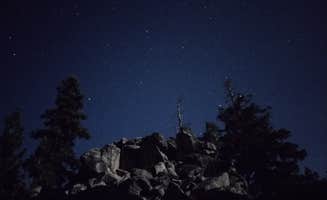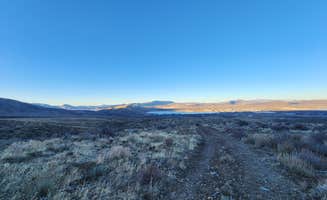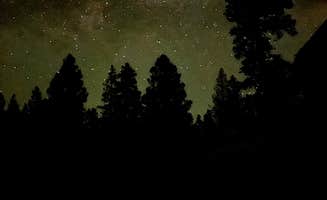Dispersed camping near Milford, California offers rugged terrain at elevations ranging from 4,000 to 5,500 feet with juniper woodlands and sagebrush dominating the landscape. Winter temperatures can drop well below freezing, while summer days typically reach 85-95°F. Most sites require visitors to pack out all waste and bring their own water supply, as natural sources are scarce in this high desert environment.
What to do
OHV riding: Fort Sage Off Highway Vehicle Area features an extensive trail network for off-highway vehicles. "Trail riding galore. Went on all the trails and out in the sand dune area we came upon wild horses, this was quite a site to see. They were just running and being playful," reports Patricia N., who recommends avoiding summer visits due to heat.
Stargazing: The dark skies provide exceptional viewing opportunities at primitive sites. At Moon Rocks Camp, camper Anna B. describes, "The moon and the stars were so bright, it felt like we were on another planet." Light pollution is minimal at most Milford-area campsites, with best viewing typically between 10 PM and 2 AM.
Wildlife observation: Many sites offer opportunities to spot local wildlife including coyotes, jackrabbits, and occasionally wild horses. "Sage and Juniper surround this area. You can even hear the coyotes calling to one another at night," notes Dani P. about Fort Sage OHV Area.
What campers like
Clean vault toilets: The quality of vault toilets at Fort Sage OHV Area consistently impresses visitors. Shirley W. states they're the "Cleanest pit toilets we've experienced anywhere," while Jordan H. notes their accessibility: "Clean bathrooms (outhouse), picnic tables, fire pit, and a great panoramic Mountain View sunset."
Quiet atmosphere: Most dispersed sites maintain a peaceful environment, especially on weekdays. At East Eagle Lake, Gregg T. reports having "the area to ourselves" and taking "a nice walk by the lake." Most campers report minimal crowding except during peak summer weekends and OHV events.
Affordability: Free camping options throughout the region allow for extended stays. Big Dog Valley camper Jake H. appreciates it as a "favorite quick escape from town" with "so many places to explore that it doesn't get old." Standard 14-day stay limits apply to most BLM sites in the region.
What you should know
Road conditions: Access varies significantly by site, with some requiring high-clearance vehicles. The CA-139 Pull Off Area has "roads to the spots are a little rutted, no low profile vehicles, but it's easy to access," according to Daisee Mae S. Fort Sage access is generally easier, with Toby T. noting the "road is well maintained gravel, no potholes."
Fire restrictions: Always check current fire regulations before visiting. While fires are permitted at most sites during cooler months, summer restrictions often prohibit open flames. The region falls under California Fire Protection jurisdiction, requiring campfire permits even for dispersed camping during permitted periods.
Weather preparedness: Temperature swings of 30-40°F between day and night are common. At Antelope Mountain Dispersed Camp, camper Alan C. warns about wind exposure: "We only found one good area... It had level sites and nice tall trees. It also tucked in out of the wind. We some for other sites but they were windy."
Tips for camping with families
Site selection: Choose locations with amenities when camping with children. Jules S. recommends Fort Sage: "EXCELLENT free campsites! Easy to get to, roughly 3-4 miles of gravel road. Campsites with tables, fire pits, and grills. Out house at current camp spot. Very clean and quiet."
Wildlife awareness: Teach children about local wildlife safety, particularly regarding coyotes. At Antelope Mountain Dispersed Camp, Tyler B. describes it as "Not a bad place to spend a night or two primitive camping" with basic cell service available for emergency communications.
Water planning: Pack 1-2 gallons of water per person per day, as no potable water exists at any dispersed sites. Fill containers in Milford or nearby towns before arrival, as the nearest reliable water source may be 30+ minutes away by vehicle.
Tips from RVers
Site spacing: Fort Sage provides ample room for larger rigs with designated sites. "Sites are nicely spaced, large and maintained," reports Toby T., while Jules S. adds you can "easily get a big rig in here" and notes having "1 bar [of AT&T], but excellent starlink."
Leveling challenges: Many dispersed areas feature uneven terrain requiring leveling blocks or careful site selection. Moon Rocks camper Genevieve R. observed that "there were some huge rigs out there" despite the primitive conditions, suggesting careful navigation is possible with larger vehicles.
Waste management: With no dump facilities at most sites, plan accordingly for holding tank capacity. "There are no amenities at all," notes Genevieve R., making proper waste management essential for responsible RV camping in these rustic locations.


